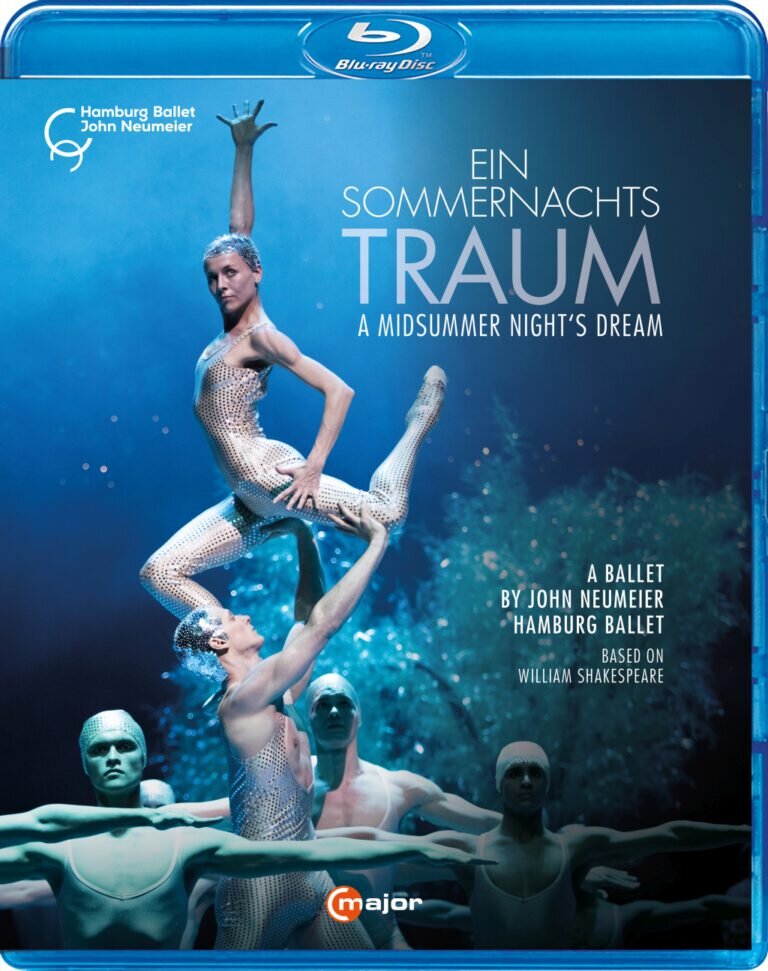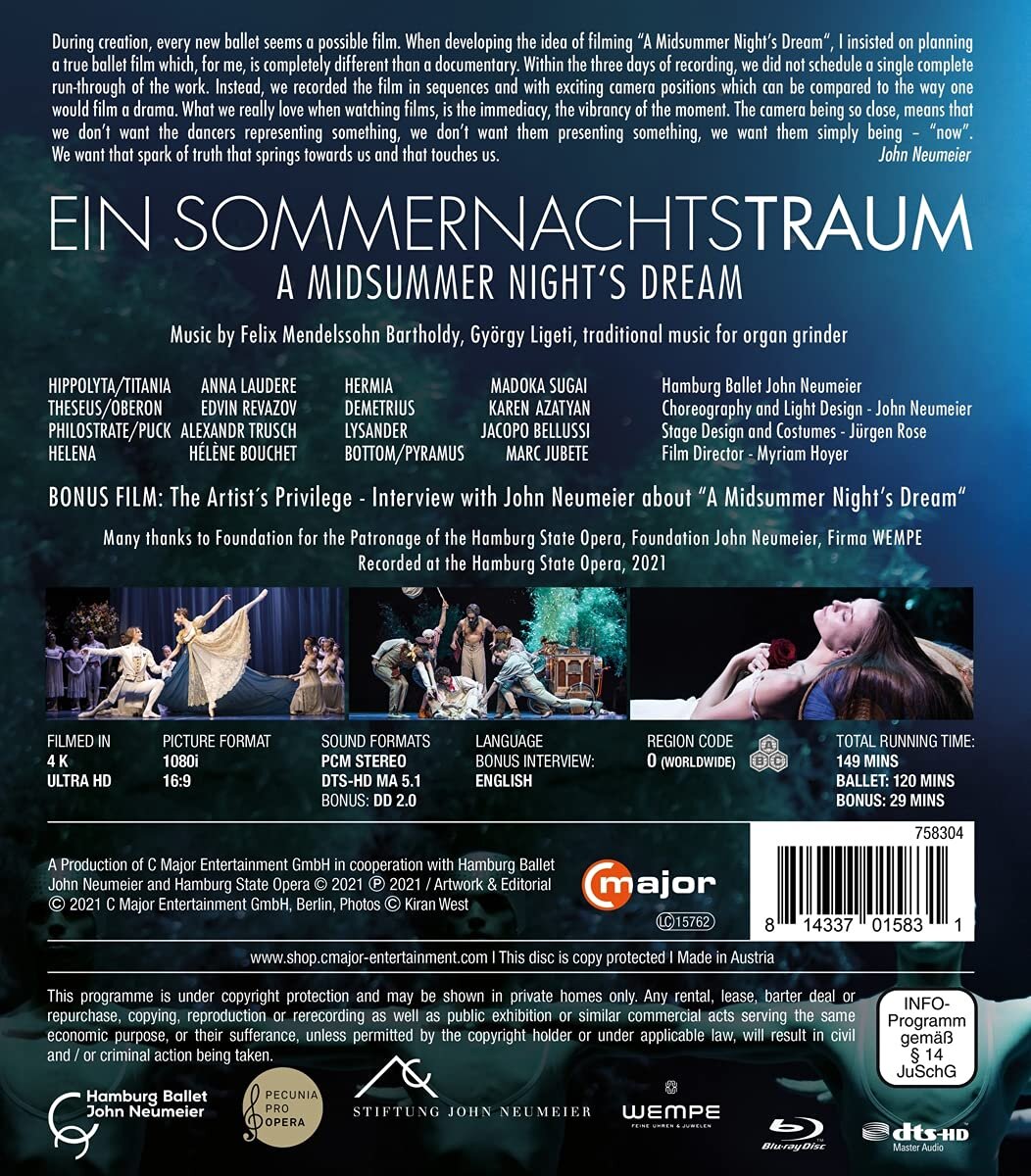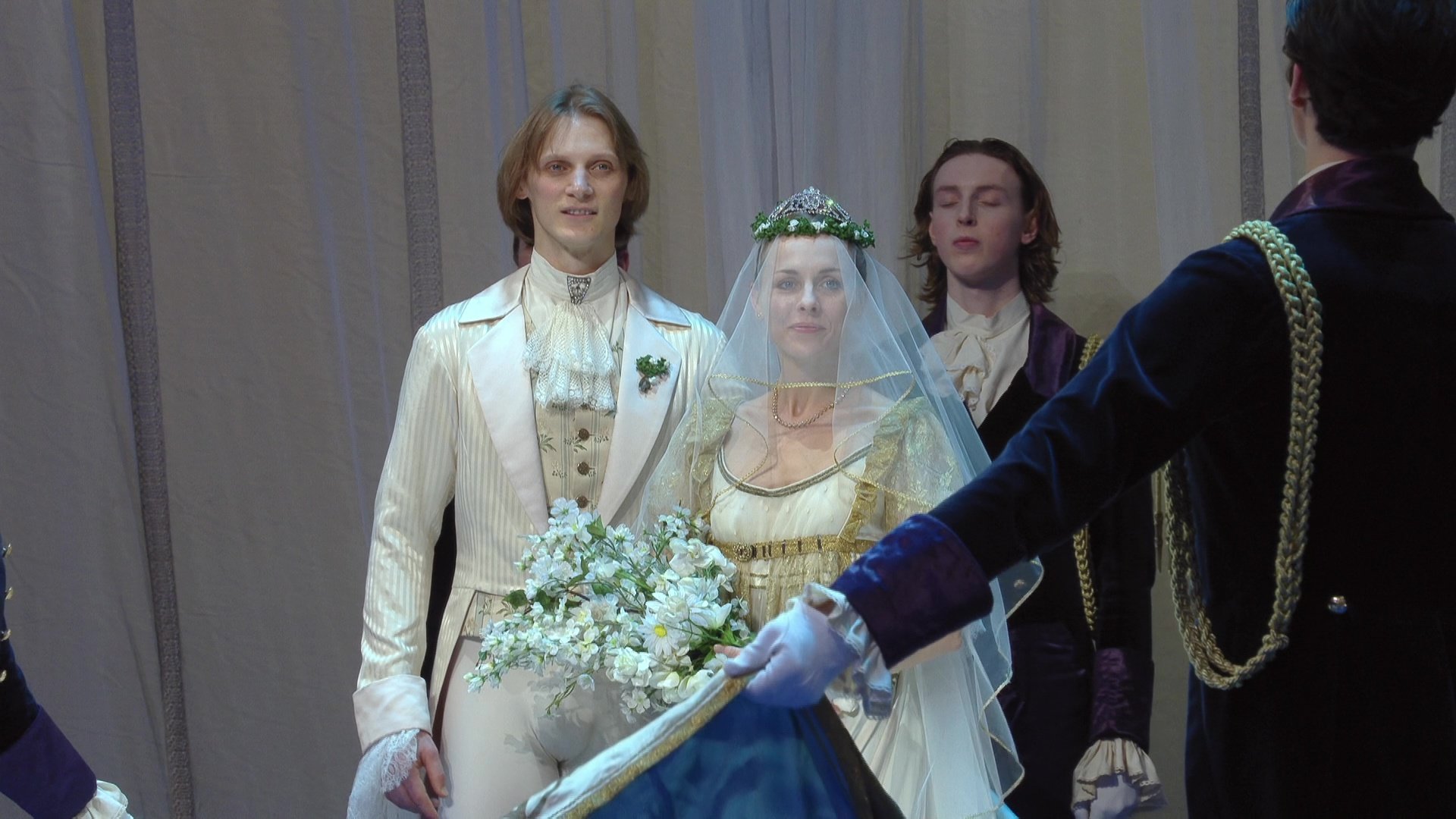

Ein Sommernachtstraum (A Midsummer Night’s Dream) ballet. Recorded music of Mendelssohn, Ligeti, and traditional tunes for organ grinder. Staged and choreographed 2021 by John Neumeier at the Hamburg Ballet. Stars Anna Laudere (Hippolyta/Titania), Edvin Revazov (Theseus/Oberon), Alexandr Trusch (Philostrate/Puck), Hélène Bouchet (Helena), Madoka Sugai (Hermia), Karen Azatyan (Demetrius), Jacopo Bellussi (Lysander), and Marc Jubete (Bottom/Pyramus) as well as many other dancers in the Hamburg Ballet. Stage design and costumes by Jürgen Rose; lighting by John Neumeier. Directed for TV by Myriam Hoyer. Incudes The Artist’s Privilege, an interview with Neumeier about this production. Released 2021, disc has 5.1 dts-HD Master Audio sound. Grade: A+
A Midsummer Night’s Dream is the most famous stage comedy in the Western tradition. Artists of every ilk have tried to adapt it including—believe it or not—synchronized swimmers. It’s a complicated play. To turn Shakespeare’s play with many interwoven plots lines into a ballet, Neumeier had to simplify and add his own twists.
Neumeier created his Sommernachtstraum in 1977. Still in repertory in Hamburg and other places, it’s maybe been the brightest star in Neumeier’s business plan ever since. So what kind of recording should Neumeier make of his cash cow? Well, even at age 82, Neumeier remains creative and inventive. So now he sets out to become motion-picture auteur!
Let me explain. Neumeier has always mostly produced shows for live audiences. He also let the industry make videos of his productions with Thomas Grimm as videographer. Neumeier calls these videos “documentaries.” They were intended to show people in their home theaters more or less what the live audience saw. I and others complained about these Neumeier/Grimm documentaries for (1) having too many video clips (too fast a pace) and (2) too often not showing the whole bodies of the dancers. We preferred the style of documentary videos made by Vincent Bataillon and others with a slower pace while showing the whole bodies of the dancers most of the time. We hung the curse of DVDitis on the Neumeier/Grimm videos.
Recently, Neumeier started working with videographer Myriam Hoyer. In Neumeier’s 2021 Ghost Light documentary, Hoyer slowed the pace down and gave more whole-body views than before of the dancers. Progress!
But with his Sommernachtstraum, Neumeier tacks a new direction, which he announces in print on the keepcase. For three days during the pandemic he used his stage in the empty opera house as a location for making a ballet “film.” The various dance sequences in the ballet were run and recorded separately, out of order, and sometimes repeatedly. The camera crews were given freedom to move about the stage making movie-like images.
Wow! Can anyone make a movie of anything—even a soap commercial—in three days? Well, Neumeier had an advantage over a typical movie director because his company can dance the material in their sleep. There were few problems with scenery, costumes, and props. Whatever the Neimeier/Hoyer team wanted, the dancers could do. After a shooting session, everyone could see the rushes immediately. To the extent music was used with the dance shots, piano or recorded music was efficient. So Neumeier and Hoyer made their film.
Let’s see how they did. We start with the main characters. Below is Hippolyta (Anna Laudere), the Amazon Princess. She is an older girl, and maybe love has passed her by. But now she is getting married to a Duke. She will have a dream. In her dream she will be Titania, Queen of the Fairies. (In the play she is a fairy about the size of your little fingernail, and that is why she is called Titania.)
The groom is Theseus (Edvin Revazov), the Duke of Athens. (This is set in Greece.) It’s a political marriage. Better to marry this Princess than to have to fight the Amazons. In the dream, the Duke will be Oberon, the King of the Fairies:
One of the young girls at the Amazon court is Hermia (Madoka Sugai). Hermia is cute and popular. In the dream, she will still be Hermia:
Another girl at court is Helena (Hélène Bouchet). She is cute too, but she has to wear those horrible glasses. She doesn’t have a boyfriend:
Lysander (Jacopo Bellussi) is one of the youths at court. He and Hermia are in love:
But Demetrius (Karen Azatyan) is also in love with Hermia:
Below left we see that Helena is in love with Demetrius. And below right we see that Lysander and Hermia are getting cozy. So one girl has two guys and another girl has nobody. This is unhappy. By the way, in both pictures below, you see a man with a yellow vest standing at attention. He is Philostrate (Alexandr Trusch), the court Master of Revels. In the dream he will be Puck:
Lysander proposes marriage to Hermia in a letter. The letter is not in Greek. It’s not in German. It’s in English! And this being a movie, I can read it! The letter says, “My Dearest, Meet me tonight at the olive tree behind the chapel and we will be married! Will you come? Please, my love. Lysander.” This is not in the play (where the lovers just agree face to face to elope). Does Neumeier use this letter in the stage ballet? Well if he does, for sure nobody in the opera house can read it. By the way, the envelope also has olive tree leaves in it—remember— we are in Athens. The motion picture auteur is at work!
Hermia is so excited she promptly loses her precious letter when she drops it on the floor. Princess Hippolyta finds it. In the next shot below, the Princess holds two marriage proposals in her hands. One is a rose delivered to her by the Duke through a messenger as part of official protocol. The other is a love letter composed, written, and delivered by a lover in his own hand. Which proposal would Hippolyta rather have received?
Troubled, our Princess needs to sleep. Below is my favorite image from Neumeier’s film. It’s just a portrait, but It has the psychological depth that we might expect from a great actress working with a clever movie director and expert cameraman:
Now to Hippolytal’s dream set in a forest of olive trees. Shakespeare’s fairies are usually presented as childlike with frilly costumes and little gossamer wings. Neumeier goes for powerful creatures bursting with sexual potency in skintight glitter suits :
Everything is shot on the regular opera/ballet stage. But the cameras can be anywhere. The parallel markings on the floor do a little to help you stay oriented. I think the image above would normally be considered center downstage (seen from the empty seating). The shot next below was shot from what would normally be stage right looking toward the empty seating. Neumeier probably regrets not obscuring those parallel lines somehow:
Neumeier/Hoyer get easy close-ups like the image below of Alexandr Trustch as Puck looking through the translucent leaves of an olive tree. Puck, you will remember, has a magic flower (that looks like the rose Hippolyta got from Theseus). If Puck waves this flower in the face of one who is asleep, then after that person wakes up, he will fall madly in love with the first creature he then sees:
Hippolyta and Theseus tangle as Titania and Oberon, Queen and King of the Fairies:
Below left we see a powerful lift downstage center. Below right is a similar lift by the same dancers shot from upstage right. In the foreground the craftsmen (known in the play as the “rude mechanicals”) enter the forest to practice a play they hope to perform for the guests at the wedding of Hippolytal and Theseus:
The dream scene has brilliant part abstract and part narrative choreography from Neumeier:
Puck first uses his magic flower to make Demetrius fall in love with nearsighted Helena. That was a nice thing to do. Puck also turns Bottom (Marc Jubete), the leader of the mechanicals, into an ass:
And Puck uses the magic flower to make Titania fall in love with the ass!
Lysander finds Hermia in the forest, and both are happy:
Lysander and Hermia are not yet married. So they chastely sleep far apart during the first night of their adventure together. Puck thinks they are having a fight. He resolves to use his magic flower to make Lysander love Hermia again:
But Puck’s grand plan is upset by fate. Helena, who has lost her glasses, comes along at just the wrong time. Lysander sees Helena when he wakes up! Now Lysander is madly in love with Helena and has forgotten Hermia!
So both men are chasing Helena, and now Hermia is the girl left out:
Oberon jumps on Puck and demands he get everything straightened out in the forest!
After more hilarious action, Puck puts the couples together correctly. Many costumes were harmed in making this film. I wonder if the abused costumes is a movie touch or part of the libretto. Well, in this film you can certainly see the ruined costumes better than a live audience would:
Bottom gets his human head back:
The dream is over. Demetrius sees Helena differently now and truly falls in love with her:
Theseus arrives and sees Hippolyta asleep. He falls in love with his fianceé. Hippolyta is not sure what to believe:
But all is well and now there’s a triple wedding:
The ballet ends at the reception later where the rude mechanicals entertain the guests with their play. Neumeier should be praised for being so faithful to the text. But to really enjoy the humor in this ending, you have to bone up on your Ovid (the story of Pyramus and Thisbe) and then read Shakespeare’s epilogue.
Our final screenshot is from the bonus feature. Center stands Myriam Hoyer, who is fast becoming the world’s leading videographer of fine-arts Blu-ray titles (best shot I could get of her). Neumeier is on the right. With this flim, he nails down again the right to be called the leading ballet choreographer working today:
Has Neumeier managed to make a ground-breaking ballet film out of his aging warhorse? He went about it like a movie director in that he made many shots of short scenes which were then edited and spliced together into a whole. The music was recorded only after the montage was complete. He maybe added some touches that would not be in a traditional video like the letter written in English. But for the most part he used the same dancers, costumes, props, lights, and location that he would use in a live performance and in a standard ( “documentary”) ballet video.
Plays, operas, and ballets are usually performed on a proscenium stage with facilities for creating effects to please the live audience. Motion pictures are usually made in all kinds of special or even natural locations using a vast variety of special effects. We have many motion picture films of Shakespeare plays made in special locations. There have been a number of operas made as motion pictures in special or natural locations with the music dubbed in once the editing of the film was over. Only a couple of these opera movies are good enough to be on our Alphalist (such as the Benoît Jacquot Tosca from 2001).
Until recently, nobody dreamed (because of the cost) of making a ballet motion picture at a special or natural location outside of an opera house. But in 2020, we got Romeo and Juliet-Beyond Words, a true ballet movie from the Royal Opera House made on a special set constructed in Hungary originally for a soap opera! See my review of Beyond Words showing how really, really hard it is to make a ballet motion picture.
Well, Neumeier doesn’t claim he’s making a movie—just a “ballet film.” It’s similar to a ballet documentary as Neumeier defines it, but with more close-ups and crazy angles plus more images in the file to pick from and edit. A traditional ballet documentary is made on the cheap by recording during the live performance without bothering the live audience too much. To make a ballet film you would only have to schedule extra performance sessions with no audience in the theater. Probably the funds to do this were never available before to any ballet company. Maybe the only reason for Neumeier’s ballet film is that he got some funds to keep his dancers busy during the pandemic.
I tried to score Neumeier’s film with a Ballet Wonk Worksheet. Along with the usual data I added a special notation for “film-like” clips. This turned out to be extremely tedious. So I only covered Chapter 1 (preparations at court for the wedding) and Chapter 2 (the fairy realm) as samples. It would appear the overall pace of this title will be almost 8 seconds per clip and that about 65% of the clips will show the whole bodies of the dancers. This isn’t great, but it’s good enough to sidestep a diagnosis of DVDitis. So I’m giving this an A+ grade.
Is Neumeier’s ballet film anything to get excited about as opposed to shooting during a live performance? This is definitely a great ballet and video. Maybe the industry will be able to tell from the number of sales whether it pays to budget time to make a ballet recording in special sessions with no audience in the house.
Here’s an official trailer—which looks to me more like a “documentary” than a movie!
OR







































